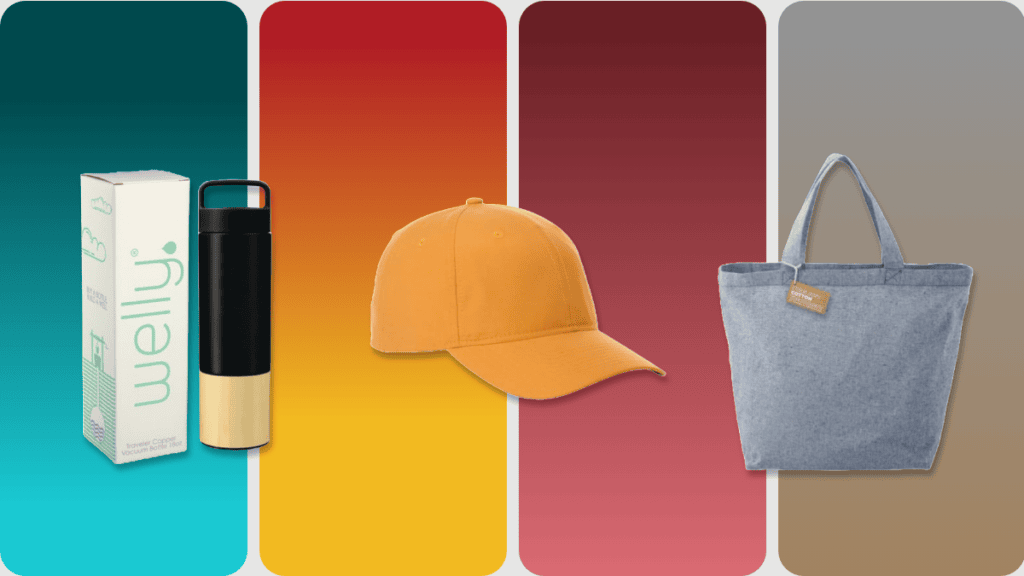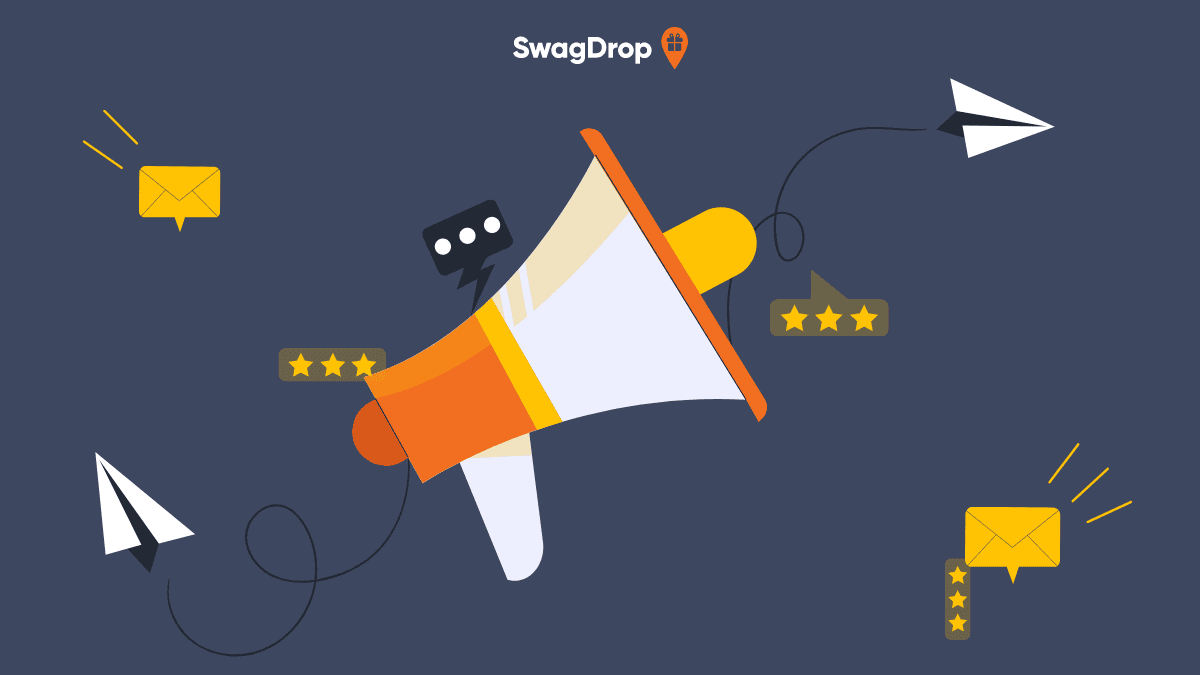Promotional products are powerful tools for building brand awareness, nurturing customer loyalty, and driving real engagement.
The only problem is that not all swag is created equal.
Cheap, forgettable branded merchandise often ends up in the trash, wasting precious resources and missing the mark.
That’s why you must pick high-quality, impactful swag that matches your brand identity and generates a high ROI.
Use our step-by-step guide to create the ultimate swag strategy and watch your brand skyrocket.
Let’s begin!

Table of Contents
Choose Swag That Reflects Your Brand
Incorporate Swag-On-Demand Shops
Frequently Asked Questions (FAQs)
Understand Your Audience
Offering giveaways is a powerful marketing strategy because consumers love getting free stuff from brands.
However, to elevate your brand marketing, you must pick meaningful promotional items that leave a lasting impression on the recipients.
Here’s how you can achieve this in two steps.
1. Identify your target audience
Start by understanding who benefits most from your brand to identify your target audience. Look at your existing customer pool and determine what they have in common.
Consider factors like age, lifestyle, and interests, and consider the promotional products that would bring the most value to their lives.
For instance, busy professionals might appreciate high-end, functional swag items, while Gen Z consumers prefer trendy, eco-friendly promo products.
2. Conduct market research
Do a bit of research to understand better what resonates with your audience. Surveys, social media polls, and customer feedback can reveal valuable insights into what your target consumers want.
You should also analyze your past marketing campaigns to identify what worked and what fell flat.
Ultimately, all this research will help you choose branded products that are used daily instead of lying forgotten in a drawer.
Now that you know who you’re targeting, it’s time to define your goals.
Set Clear Objectives
Determining what you want to achieve is the key to building a winning marketing campaign.
Without clear objectives, you risk spending money on branded merch that doesn’t yield the desired results.
Your swag campaign can serve various goals, such as:
- Increasing lead generation
- Building brand awareness
- Enhancing customer engagement
- Driving brand loyalty and customer retention
Defining your primary goal will shape your entire marketing strategy.
For instance, you can offer exclusive corporate gifts for newsletter sign-ups to generate more leads, enticing potential customers to share their contact info.
Once you’ve set the objectives, you must figure out how much you can spend on your promotional campaign.
Budget for Success
An effective swag campaign balances cost, quality, and impact.
Overspending can drain your marketing budget, while cutting costs too much may result in low-quality, forgettable merch.
Therefore, you must develop a solid swag procurement strategy. Here are some practical tips on how to allocate resources wisely:
Define your budget: Determine how much you can afford to invest in branded swag without putting too big a dent in your company’s finances.
Prioritize quality over quantity: A smaller batch of high-quality, useful swag makes a bigger impact than thousands of cheap promo items that get thrown away.
Break down costs: Be aware of all these swag-related expenses to avoid any unexpected costs:
- Product design and customization
- Manufacturing and printing
- Packaging and shipping
- Storage and fulfillment
Look for good deals: Take advantage of seasonal promotions, like Black Friday, to buy promotional items at a reduced price.
Likewise, search for swag vendors, like SwagDrop, who always offer bulk order discounts.
For more practical wisdom, check out our insightful article How to set a cost-efficient swag budget.
Next, we’ll show you how to choose the right swag for your brand.
Choose Swag That Reflects Your Brand
Your promotional materials should feel like an extension of your brand identity.

Here’s what you should do to make that happen:
1. Be consistent
Use your brand’s colors, fonts, and logo to maintain consistency across all your branded merchandise.
Likewise, pick swag items that align with your company culture and values.
For example, if you advocate for environmental sustainability, handing out reusable tote bags made from recycled materials is the way to go.
Of course, with consumers becoming more conscious than ever about waste and ethical sourcing, we recommend always prioritizing sustainability.
In fact, according to the 2023 ASI report, 46% of US consumers would have a better opinion about a brand if it offered them an eco-friendly promotional item.
2. Prioritize functionality and value
Choose company swag that consumers will frequently use long-term, increasing brand exposure. At the same time, factor in your target audience’s interests to select giveaways that resonate with them.
Tech brands can offer high-end Bluetooth headphones, while fitness brands can give out insulated water bottles.
3. Keep up with the seasons and trends
Generate buzz around your brand all year round with season-themed swag.
Cozy hoodies and knitted mittens make a big impact during winter, for example, while colorful t-shirts and baseball caps are popular summer giveaways.
Moreover, you should always stay ahead of the trends to keep customers engaged. For instance, branded fanny packs have come back in recent years and are now a hip fashion accessory you should consider.
Now, let us introduce you to a powerful tool that will make your life a lot easier.
Incorporate Swag-On-Demand Shops
Say goodbye to the headache of bulk orders and the chaos of swag distribution!
Instead, opt for SwagDrop’s swag-on-demand shops, our all-in-one solution for stress-free corporate gifting campaigns. Check out some of the fantastic features of these virtual stores:
- You can get your swag gift store up and running in just a few hours, complete with your company logo and a personalized welcome message.
- Choose from high-quality promotional gifts that will make your brand stand out.
- Set a promo item limit or offer users store credit.
- Guests choose the branded swag they want in their preferred color or size, making the entire experience more personal and memorable.
- No need to worry about storage costs, inventory management, or leftover swag because we only print on demand.
- Enjoy fast and budget-friendly drop-shipping. Every order is delivered to the recipient’s doorstep for just $9.95 across the continental USA.
Our standout tool can be used for client appreciation gifts or giveaways offered at corporate events, such as brand launches, trade shows, or Christmas parties.
Next, we’ll explore some of the most popular swag distribution strategies.
Distribution Strategies
The swag distribution strategy you choose depends on your goals, audience, and the type of campaign you want to run:
1. In-person events
At in-person events like trade shows or conferences, eye-catching promotional items can attract attendees and spark meaningful conversations.
You can opt for a fashionable, eco-friendly tote bag, including a power bank to keep the recipient’s phone charged throughout the event and promotional candy to indulge in.
2. Virtual events
Social media contests and giveaways are a powerful way to expand your reach and engage the audience. Once again, it’s all about choosing fabulous swag to catch users’ eyes and entice them to participate.
Don’t forget to ask the winners to share photos with their promotional gifts on social media for maximum exposure.
3. Direct mail
Show your appreciation to loyal customers by mailing them a well-packaged, personalized swag box full of goodies. This meaningful gesture will reinforce your bond, boosting customer loyalty and retention.
As for your VIP clients, we recommend going the extra mile with a luxury promotional product that will leave a lasting impression.
Finally, let’s see how you can measure the success of your swag campaigns.
Measure ROI and Effectiveness
Measuring the ROI and effectiveness of your promotional products campaign can help you determine whether you’re investing in the right swag.
Use these key metrics and tactics to measure performance:
- Track engagement using unique promo codes, QR codes, or landing pages to see how many people interact with your branded items.
- Monitor brand impressions by counting the number of times your swag is seen through social media posts, office use, or public exposure.
- Survey recipients to understand your promo products’ impact and learn what swag items would better resonate with them.
- Compare sales and leads to identify potential spikes occurring after your swag distribution.
This data helps you optimize your marketing strategy, increase impact, and make informed decisions about future campaigns.
Now, it’s your turn to shine!
Tips, tricks, and inspiration delivered straight to your inbox.
Over to you!
A well-planned swag strategy turns simple giveaways into powerful brand builders. With the right swag, you can build brand awareness, drive engagement, and generate a high ROI.
It’s time to put all this knowledge to good use and create a memorable and effective promotional campaign.
Browse our SwagDrop shop today and start ordering promotional items to wow your audience.
Frequently Asked Questions (FAQs)
Here are the answers to some of the questions you might still have.
What is a swag strategy?
A swag strategy is a strategic approach to selecting, designing, and distributing promotional merchandise to elevate a brand’s marketing. The main objective is to pick high-quality, useful, and impactful swag that drives brand awareness, customer engagement, and loyalty while maximizing the return on investment (ROI).
Why is a swag strategy important?
A well-thought-out swag strategy is important because it makes sure that:
- Promotional items reinforce brand identity
- Swag items are valuable and memorable and won’t go to waste
- The marketing budget is effectively spent
- Existing and potential customers feel truly appreciated
What are common use cases for swag in marketing?
Brands typically use swag in the following cases:
- At trade shows and corporate events to attract and engage attendees while also leaving a lasting impression.
- As social media giveaways to boost engagement and brand visibility.
- As corporate gifts to clients and stakeholders to strengthen your relationship.
- As rewards for VIP or repeat customers to build brand loyalty.
- As employee incentives to improve morale, engagement, and retention.
What types of swag are most effective for brand awareness?
Here are some examples of swag items that enhance brand awareness:
- Everyday essentials, as in branded notebooks, tote bags, and Bluetooth earbuds.
- Tech swag, including Bluetooth speakers, power banks, and wireless chargers.
- Branded apparel, such as t-shirts, hoodies, and hats.
- Drinkware, like custom mugs, tumblers, insulated water bottles.
What mistakes should companies avoid in their swag strategy?
Companies should avoid the following mistakes in their swag strategy:
- Choosing low-quality products that can damage a brand’s reputation.
- Failing to take into account the target audience’s interests and likes when picking swag.
- Overstocking on promo items, giving rise to environmental and financial waste.
- Failing to consider logo placement and brand colors, resulting in low-impact swag.
How can small businesses implement a swag strategy on a budget?
Small businesses can implement a swag strategy on a budget by:
- Choosing a few quality products instead of countless cheap items.
- Using swag-on-demand shops to avoid bulk ordering of unwanted products.
- Investing only in practical promo items that won’t be thrown away.
- Offering virtual swag, like discount codes or e-gift cards.


